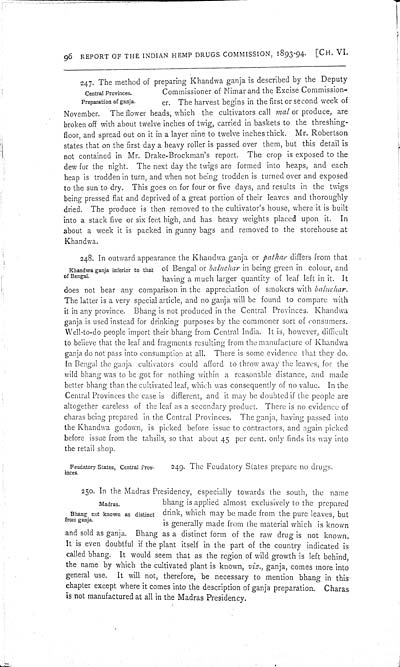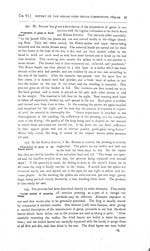Medicine - Drugs > Report of the Indian Hemp Drugs Commission, 1894-1895 > Volume I
(123) Page 96
Download files
Individual page:
Thumbnail gallery: Grid view | List view

96 REPORT OF THE INDIAN HEMP DRUGS COMMISSION, 1893-94. [CH. VI.
Central Provinces.
Preparation of ganja.
247. The method of
preparing Khandwa ganja is described by the Deputy
Commissioner of Nimar and
the Excise Commission-
er. The harvest begins in the first or second week of
November. The flower heads,
which the cultivators call mal or produce, are
broken off with about twelve inches of twig, carried in baskets to
the threshing-
floor, and spread out on it in a layer nine to twelve inches thick.
Mr. Robertson
states that on the first day a heavy roller is passed over them,
but this detail is
not contained in Mr. Drake-Brockman's report. The crop is exposed
to the
dew for the night. The next day the twigs are formed into heaps,
and each
heap is trodden in turn, and when not being trodden is turned over
and exposed
to the sun to dry. This goes on for four or five days, and results
in the twigs
being pressed flat and deprived of a great portion of their leaves
and thoroughly
dried. The produce is then removed to the cultivator's house, where
it is built
into a stack five or six feet high, and has heavy weights placed
upon it. In
about a week it is packed in gunny bags and removed to the
storehouse at
Khandwa.
Khandwa ganja inferior to
that
of Bengal.
248. In outward
appearance the Khandwa ganja or pathar differs from
that
of Bengal or baluchar
in being green in colour, and
having a much larger quantity of leaf left in it. It
does not bear any comparison
in the appreciation of smokers with baluchar.
The
latter is a very special article, and no ganja will be found to
compare with
it in any province. Bhang is not produced in the Central Provinces.
Khandwa
ganja is used instead for drinking purposes by the commoner sort of
consumers.
Well-to-do people import their bhang from Central India. It is,
however, difficult
to believe that the leaf and fragments resulting from the
manufacture of Khandwa
ganja do not pass into consumption at all. There is some evidence
that they do.
In Bengal the ganja cultivators could afford to throw away the
leaves, for the
wild bhang was to be got for nothing within a reasonable distance,
and made
better bhang than the cultivated leaf, which was consequently of no
value. In the
Central Provinces the case is different, and it may be doubted if
the people are
altogether careless of the leaf as a secondary product. There is no
evidence of
charas being prepared in the Central Provinces. The ganja, having
passed into
the Khandwa godown, is picked before issue to contractors, and
again picked
before issue from the tahsils, so that about 45 per cent. only
finds its way into
the retail shop.
Feudatory States, Central
Prov-
inces.
249. The Feudatory States prepare no drugs.
Madras.
Bhang not known as
distinct
from ganja.
250. In the Madras
Presidency, especially towards the south, the name
bhang is applied almost
exclusively to the prepared
drink, which may be made from the pure leaves, but
is generally made from the material which is known
and sold as ganja. Bhang as
a distinct form of the raw drug is not known,
It is even doubtful if the plant itself in the part of the country
indicated is
called bhang. It would seem that as the region of wild growth is
left behind,
the name by which the cultivated plant is known, viz.,
ganja, comes more into
general use. It will not, therefore, be necessary to mention bhang
in this
chapter except where it comes into the description of ganja
preparation. Charas
is not manufactured at all in the Madras Presidency.
Set display mode to: Large image | Zoom image | Transcription
Images and transcriptions on this page, including medium image downloads, may be used under the Creative Commons Attribution 4.0 International Licence unless otherwise stated. ![]()
| India Papers > Medicine - Drugs > Report of the Indian Hemp Drugs Commission, 1894-1895 > Volume I > (123) Page 96 |
|---|
| Permanent URL | https://digital.nls.uk/74574314 |
|---|---|
| Description | Chapter VI, cont. |
| Description | [Volume 1]: Report. |
|---|---|
| Attribution and copyright: |
|




